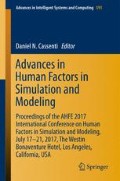Abstract
To perform a successful workplace examination, miners must be able to find and fix hazards. The goal of the current research project was to identify differences in how workers with varying amounts of work and safety experience search and identify hazards. The NIOSH research team created true-to-life panoramic images that safety professionals, experienced miners, inexperienced miners, and students searched for hazards. The effects of the image context and experience level of the participants on the overall accuracy are explored. The research findings suggest that safety experience and hazard familiarity play a large role in a miner’s ability to identify hazards. Findings from this study will be incorporated into training programs focused on improving hazard recognition ability for surface stone, sand, and gravel miners.
Access this chapter
Tax calculation will be finalised at checkout
Purchases are for personal use only
References
Mine Safety and Health Administration. Accident: Illness and Injury and Employment Self-Extracting Files (Part 50 Data). http://www.msha.gov/STATS/PART50/p50y2k/p50y2k.htm
Mine Safety and Health Administration: Examinations of working places in metal and nonmetal mines. Final Rule Fed. Reg. 82, 7680–7695 (2017)
Mine Safety and Health Administration: Definitions. In: Code of Federal Regulations. Title30, Part 56.2 (2015)
Scharf, T., Vaught, C., Kidd, P., Steiner, L., Kowalski, K., Wiehagen, B., Rethi, L., Cole, H.: Toward a typology of dynamic and hazardous work environments. Hum. Ecol. Risk Assess. 7(7), 1827–1842 (2001)
Mitropoulos, P., Abdelhamid, T., Howell, G.: Systems model of construction accident causation. J. Constr. Eng. Manag. 131(7), 816–825 (2005)
Bahn, S.: Workplace hazard identification and management: the case of an underground mining operation. Saf. Sci. 57, 129–137 (2013)
Albert, A., Hallowell, M.R., Kleiner, B., Chen, A., Golparvar-Fard, M.: Enhancing construction hazard recognition with high-fidelity augmented virtuality. J. Constr. Eng. Manag. 140(7), 04014024 (2014)
Hunter, D.R.: Risk Perception and Risk Tolerance in Aircraft Pilots. Federal Aviation Administration, Washington (2002)
Barrett, E., Kowalski, K.: Effective Hazard Recognition Training Using a Latent-Image, Three-Dimensional Slide Simulation Exercise. Report of Investigations, vol. 9527, pp. 1–36. Bureau of Mines, Washington, DC (1994)
Perlman, A., Sacks, R., Barak, R.: Hazard recognition and risk perception in construction. Saf. Sci. 64, 22–31 (2014)
Burke, M.J., Scheuer, M.L., Meredith, R.J.: A dialogical approach to skill development: the case of safety skills. HRMR 17(2), 235–250 (2007)
Henderson, J.M., Hollingworth, A.: Eye movements during scene viewing: an overview. In: Underwood, G. (ed.) Eye Guidance in Reading and Scene Perception, pp. 269–293. Elsevier, Oxford (1998)
Oliva, A., Torralba, A.: The role of context in object recognition. Trends. Cogn. Sci. 11(12), 520–527 (2007)
Kowalski-Trakofler, K.M., Barrett, E.A.: The concept of degraded images applied to hazard recognition training in mining for reduction of lost-time injuries. J. Saf. Res. 34(5), 515–525 (2003)
Dupont, L., Antrop, M., Van Eetvelde, V.: Eye-tracking analysis in landscape perception research: influence of photograph properties and landscape characteristics. Landsc. Res. 39(4), 417–432 (2014)
Drury, C.G., Clement, M.R.: The effect of area, density, and number of background characters on visual search. Hum. Factors 20(5), 597–602 (1978)
Underwood, G.: Visual attention and the transition from novice to advanced driver. Ergonomics 50(8), 1235–1249 (2007)
Stinson, C., Kopper, R., Scerbo, B., Ragan, E., Bowman, D.: The effects of visual realism on training transfer in immersive virtual environments. In: Proceedings of Human Systems Integration Symposium (2011)
FMCSA.: Physical Qualifications for Drivers. Code of Federal Regulations. Title 49, Part 391.41 (2015)
McWilliams, L., Lenart, P., Lancaster, J., Zeiner Jr., J.R.: National survey of the mining population, part I: employees. Off. Mine Saf. Health Res. Inf. Circ. 9527, 252 (2012)
Mine Safety and Health Administration: Training and Retraining of Miners Engaged in Shell Dredging or Employed at Sand, Gravel, Surface Stone, Surface Clay, Colloidal Phosphate, or Surface Limestone Mines. Code of Federal Regulations. Title 30 Part 46 (1999)
Bellanca, J., Orr, T., Helfrich, W., Macdonald, B., Navoyski, J., Eiter, B.: Assessing hazard identification in surface stone mines in a virtual environment. In: Vincent, G.D. (ed.) Advances in Applied Digital Human Modeling and Simulation, pp. 217–230. Springer, Cham (2016)
Salvucci, D.D., Goldberg, J.H.: Identifying fixations and saccades in eye-tracking protocols. In: Proceedings of the 2000 Symposium on Eye Tracking Research and Applications. ACM (2000)
Hale, S., Myerson, J., Smith, G.A., Poon, L.W.: Age, variability, and speed: between-subjects diversity. Psyc. Aging 3(4), 407–410 (1988)
Dzeng, R.J., Lin, C.T., Fang, Y.C.: Using eye-tracker to compare search patterns between experienced and novice workers for site hazard identification. Saf. Sci. 82, 56–67 (2016)
Acknowledgments
NIOSH would like to thank Holly Tonini for her help in taking and editing the panoramic images. The findings and conclusions are those of the authors and do not necessarily represent the views of NIOSH.
Author information
Authors and Affiliations
Corresponding author
Editor information
Editors and Affiliations
Rights and permissions
Copyright information
© 2018 Springer International Publishing AG (outside the USA)
About this paper
Cite this paper
Eiter, B.M. et al. (2018). Recognizing Mine Site Hazards: Identifying Differences in Hazard Recognition Ability for Experienced and New Mineworkers. In: Cassenti, D. (eds) Advances in Human Factors in Simulation and Modeling. AHFE 2017. Advances in Intelligent Systems and Computing, vol 591. Springer, Cham. https://doi.org/10.1007/978-3-319-60591-3_10
Download citation
DOI: https://doi.org/10.1007/978-3-319-60591-3_10
Published:
Publisher Name: Springer, Cham
Print ISBN: 978-3-319-60590-6
Online ISBN: 978-3-319-60591-3
eBook Packages: EngineeringEngineering (R0)

